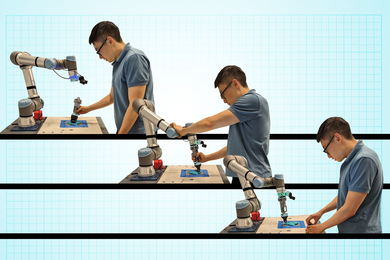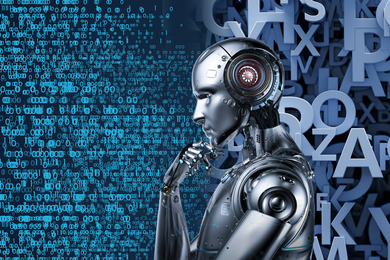By recounting many of the challenges faced-and met-by engineers involved in the Apollo 11 mission to the Moon, Neil A. Armstrong and MIT's Robert C. Seamans Jr. succeeded last week in vividly reminding an overflow crowd of the magnitude of the United States' achievement when Armstrong took that first step on July 20, 1969.
Their talks also brought home the significant contributions of MIT engineers and alumni. In the audience was Buzz E. Aldrin (MIT SB '63 and ScD), Mr. Armstrong's "hiking partner," according to Professor Earll M. Murman, head of the Department of Aeronautics and Astronautics, who introduced the speakers.
Mr. Armstrong and Dr. Seamans also commented on other issues at a question and answer session following the program. For example, when asked whether he is concerned about reduced funding levels for today's space program, Mr. Armstrong said that he was "a little disappointed that more things aren't being initiated and less new projects are being supported," but wouldn't comment on specific programs that should be backed. On a lighter note, he revealed that he's never played the game Lunar Lander. (The questioner was "curious as to whether or not the game was accurate.")
Mr. Armstrong focused his talk on those parts of the flight involved in getting from lunar orbit to the surface of the moon. "The requirements were relatively simple," he said with a smile. "Begin in lunar orbit, and end up parked on the surface, hopefully in suitable conditions to take off."
One of the technical challenges he discussed was development of the rocket engine used in the descent to the surface. Among the requirements: "somehow this rocket needed to provide a wide variation in thrust," Mr. Armstrong said. "To efficiently decelerate from orbital velocity required a high thrust level; landing required a relatively low thrust level." At that time, however, "most rocket engines operated at essentially fixed thrust."
Coupled with other technical challenges such as the selection of a propellant, Mr. Armstrong concluded that "there were many engineering accomplishments in Apollo, but many believe that the descent engine was one of the most outstanding."
Mr. Armstrong also talked about the inertial guidance system developed at the Charles Stark Draper Laboratory (then MIT's Instrumentation Laboratory) for guidance, navigation and control of the Command and Lunar Modules. (The Lunar Module took Armstrong and Aldrin to the surface andthen returned them to the Command Module orbiting above.)
Among the key components of the system was the computer that included the navigation logic for calculating the guidance commands. "It was a 70-pound, 16-bit machine," Mr. Armstrong said. "By today's workstation standard, or even in comparison with a Mac or a PC, it was a primitive device, but it was far advanced over anything we'd had up to that time and we were delighted to have it, even though it cost more than a small country."
He mentioned that two people at the Instrumentation Lab who were "largely responsible" for the success of the system were in the audience-Richard H. Battin and George Cherry. (Dr. Battin is now a senior lecturer in the Department of Aeronautics and Astronautics.)
Dr. Seamans, who played a major role in the Apollo 11 program as a leading NASA administrator, discussed such technical issues as the method for assembly of the spacecraft and the testing of its components. Dr. Seamans, also an MIT alumnus, has held many positions at MIT, including Dean of Engineering; he is currently a senior lecturer in the Department of Aeronautics and Astronautics.
With respect to testing, Dr. Seamans said that early on, engineers realized that "we couldn't reach our goal by testing [each component] step by step." So the team adopted the approach of testing "as much hardware as possible" on the missions preceding Apollo 11.
One member of the audience later asked the speakers "how the pilots reacted to that approach to testing-not rigorously testing each system independently?" Mr. Armstrong responded that "those of us who'd been involved in test flying had become advocates of the step-at-a-time system, and it was difficult for us to accept the idea that we were going to test everything at the same time.
"Nevertheless," he said, "what we didn't appreciate then was the increased confidence level that could be achieved by very diligent componentry and systems testing before we got to flight. It was a level of concentration that we had not been through and didn't previously recognize the value of."
Dr. Seamans also related a 1962 visit from President Kennedy and Vice President Johnson, among others, to the Marshall Space Flight Center at Huntsville, AL. The entourage included Wernher von Braun, Secretary of Defense Robert McNamara, and MIT President Emeritus Jerome Weisner (then Kennedy's science advisor).
At that time, Dr. Seamans said, NASA had not yet decided on the exact approach for getting to the moon. He remembered: "The group ended up inside one of the large assembly hangers and right on the floor of this big building, Kennedy started asking me about the pros and cons of [the different mission approaches then under consideration]."
A large group of reporters "could see this earnest discussion," Dr. Seamans said, "and needless to say, there was plenty of probing by the press after this had taken place. But when everything was taken into account, reason prevailed and the Apollo mission was conducted by lunar orbit rendezvous."
Dr. Seamans put the overall mission in perspective when he concluded: "Sometimes I have to admit that when I see the Moon coming over the horizon I find it hard to believe that it really happened."
The talks by Dr. Seamans and Mr. Armstrong, who were honored by a long standing ovation, constituted the 25th Lester D. Gardner Lecture. The lecture was sponsored by the Department of Aeronautics and Astronautics and the New England Section of the American Institute of Aeronautics and Astronautics.
A version of this article appeared in the May 11, 1994 issue of MIT Tech Talk (Volume 38, Number 32).





